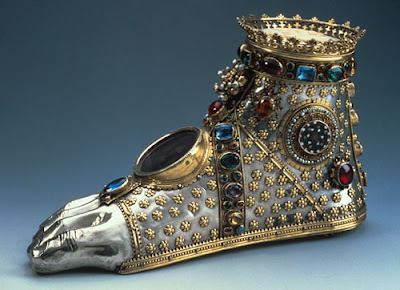Introduction to the Basel Foot Reliquary
The Basel Foot Reliquary is a unique treasure of medieval Europe, standing out as an exceptional example of religious devotion and artistic excellence. Created around 1450, this intricately crafted artifact, made of gold and adorned with precious stones, is housed in the Cathedral Treasury of Basel, Switzerland, and now part of the National Museum of Switzerland collection. Its unusual design, shaped like a human foot, distinguishes it from typical reliquaries and highlights the interplay between physical representation and spiritual significance.
Historical and Religious Context
During the Middle Ages, reliquaries played a central role in Christian worship and devotion. These ornate containers were designed to house sacred relics, such as the bones, clothing, or personal items of saints. The Basel Foot Reliquary, shaped to mimic the human form, exemplifies the medieval belief in the tangible connection between the divine and the physical world. Such objects were not only venerated but also served as visual reminders of faith, attracting pilgrims and reinforcing the church’s authority and wealth.
Symbolism of the Foot Design
The choice of a foot shape is particularly symbolic. In Christian tradition, the foot often represents humility and pilgrimage, themes central to medieval spirituality. Feet were also associated with acts of devotion, such as washing the feet of pilgrims or the biblical story of Christ washing his disciples’ feet. By creating a reliquary in this form, artisans and patrons conveyed a profound spiritual message, combining reverence with a human touch.

Artistic Mastery and Craftsmanship
Materials and Design
The Basel Foot Reliquary showcases extraordinary craftsmanship. Made from gold and encrusted with precious stones, its opulent materials reflect the wealth and reverence of its patrons. The meticulous attention to detail—down to the lifelike proportions and decorations—highlights the skill of medieval goldsmiths, who balanced functionality with aesthetic appeal.
A Blend of Art and Faith
This reliquary bridges the gap between artistic expression and religious devotion. While its primary function was to house a sacred relic, it also served as a visual statement of faith and status. Its exquisite design not only inspired awe but also acted as a physical embodiment of the sacred, reinforcing the connection between heaven and earth.

Legacy and Cultural Significance
Preservation and Display
Now part of the National Museum of Switzerland, the Basel Foot Reliquary continues to captivate historians, art enthusiasts, and religious scholars. Its preservation allows modern audiences to appreciate the intricate craftsmanship and the rich religious traditions of medieval Europe.
A Window into the Middle Ages
The reliquary offers insights into the cultural, spiritual, and artistic values of its time. It reflects the medieval fascination with blending the human and the divine, as well as the period’s dedication to honoring sacred relics through art.
Conclusion
The Basel Foot Reliquary is more than an artifact; it is a testament to the profound interplay of faith, art, and symbolism in medieval Europe. Its intricate design and deep spiritual significance offer a glimpse into the era’s devotion and artistry. As both a historical and cultural treasure, it continues to inspire admiration and curiosity, bridging the past and present through its timeless beauty.
